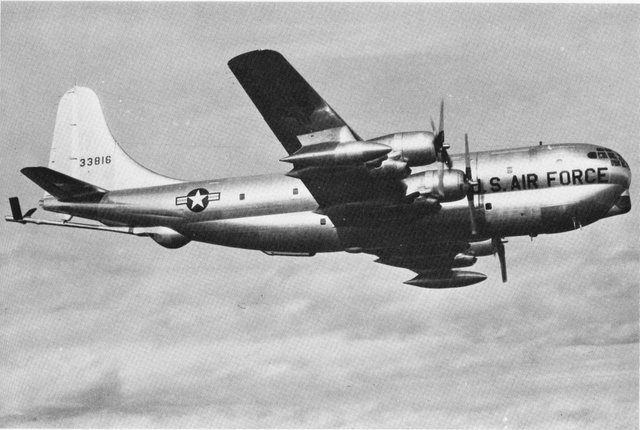The KC-97 Stratofreighter - "They Made the Range"

The last production KC-97, nicknamed 888 after the KC-97's production run, served at Lincoln with the 98th AREFS (USAF Photo)
KC-97s at Lincoln (or deployed) gallery
Boeing KC-97 Stratofreighter
Class: Medium Air-Refueling/Transport
Crew: 6 (pilot, co-pilot, navigator, flight engineer, radio operator, boom operator)
Maximum Speed: 400 mph
Radius: 2,300 miles
Service Ceiling:
Fuel Load: 9,000 gallons
Length: 117 ft
Wingspan: 141 ft
Height: 38 ft
Empty Weight: 82,500 lb
Gross Weight: 153,000 lb
Powerplant: 4 Pratt & Whitney R-4360-59 Wasp Major radial piston engines
Operators at Lincoln: 98th Air-Refueling Squadron and 307th Air-Refueling Squadron

Brief History:
The direct ancestor of today's KC-135 Stratotanker, the KC-97 made its presence known over Lincoln skies for nearly 10 years. Descending itself from the B-29 bomber, this aircraft was SAC's workhorse tanker and transport during its peak aircraft years. Of nearly 900 airframes built, the last of these was delivered to the 98th Air Refueling Squadron at Lincoln AFB in 1956.
History
The KC-97 was a continuing development (and perhaps the ultimate expression of the original Superfortress design) of the B-29. First flown in 1944 as the C-97, it was first envisioned purely for air-transport duties. Moreover the C-97 came from the B-50's airframe (a longer-ranged, upgraded engine expression of the B-29) yet a larger, ballooned out upper section was placed upon the smaller airframe below (the lines below "U.S. Air Force" clearly explore this double-deck arrangement above). Now outfitted with wing tanks and much more powerful and economic radial engines, the C-97 now could offer heavier lift capability to the Army Air Force.
SAC life
As SAC explored the concept of air-refueling using the "flying-boom" method (that of a telescopic pipe that aerodynamically was maneuvered into the refueling port of the receiving aircraft) with the B-29 (KB-29). The KB-29 of course could not offer the range or the fuel capacity the Air Force was looking for to supplement its new B-47 jet bomber force soon to come online. While the Air Force worried somewhat over the KC-97's need for higher speed to keep up with the new jet bomber they had no other practical choice for a good, long-range tanker capable of satisfying the thirst of the early jet bombers.
KC-97s came online during the early 1950s along side B-47s. In 1954 meanwhile the 98th and 307th Air Refueling Squadrons were activated at Lincoln AFB in Nebraska and soon began receiving these aircraft. In what would become a crucial link, KC-97s and B-47s stood along the Lincoln flightline ready to take the fight to a distant enemy. Without the KC-97s, Lincoln and other American B-47 wings stood no chance of attacking the Soviet Union utilizing their internal fuel alone.
Through 1960, Lincoln KC-97s were flown to various locations including Newfoundland, Canada and Thule Air Base in Greenland to support SAC's global bomber operations. During 1960 the 307th Air Refueling Squadron was relocated to Selfridge AFB Michigan to better support SAC operations. 98th Air Refueling Squadron tankers soldiered on until 1963 when it was deactivated.
After Lincoln
KC-97s remained in SAC's fleet until 1965 and then in the Air National Guard until the late 1970s.
98th Air Refueling Squadron Page
307th Air Refueling Squadron Page
The Story of 52-2718 (Lincoln's last airworthy KC-97)
More To Come Later!
Suggested Reading:
Hill, Michael "Cold War Cornhuskers" Schiffer books
Yenne, Bill "Boeing 377 Stratocruiser and KC-97 Stratofreighter" Crecy Books